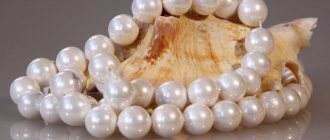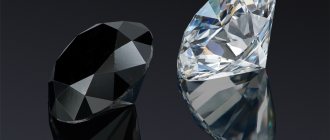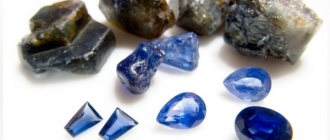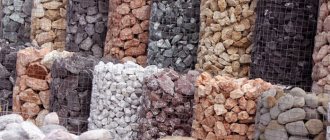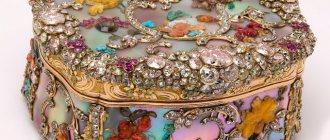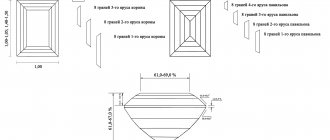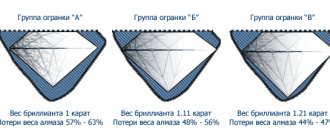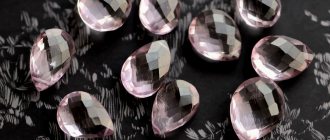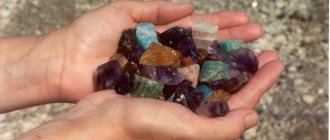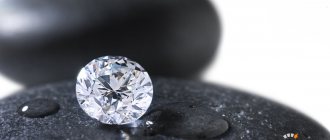This article discusses the terminology of precious stones, and also provides the main classifications
In the photo: the color palette of spinel, which is gaining popularity in Russia
This article discusses the main criteria by which the category of precious stones is distinguished. The names of terms such as jewelry, ornamental, semi-precious, colored and precious stones, and semi-precious stones are explained.
Various classifications with types and names are given:
- - classification by K. Kluge;
- - classification of G. Gurich;
- - classification by M. Bauer - A.E. Fersman;
- - classification by V.I. Sobolevsky;
- - classification by E.Ya. Kievlenko;
- -industrial classification of natural jewelry and ornamental stones of VNIIyuvelirprom;
- - classification E.P. Melnikova.
Gemstone concept. Features of terminology
We have all heard about the existence of a special category of precious stones. Let's try to figure out which ones are considered precious. “Rocks” usually refer to minerals and/or rocks formed in nature without human intervention. And in order to understand what belongs to precious stones and what does not, you need to know the definition of the criteria for “jewelry” in a general sense or in a legal sense (as far as Russia is concerned).
What stones are considered precious? There is no generally accepted definition of the concept of “gemstone” today. In a general sense, this category includes only those natural stones that satisfy three main criteria: beauty, rarity and durability.
The beauty of a specimen is determined by its color, shine, play, as well as other optical properties. It is beauty that determines a person’s desire to become the owner of a stone or jewelry with it.
Rarity (or uniqueness) is determined by the prevalence of a given mineral in nature. Different varieties of minerals can be expensive due to the fact that they are very difficult to find and extract in nature.
Durability depends on its strength. Strength (wear resistance) is affected by the hardness, fragility, cleavage and other properties of the stone.
The consequence of the above criteria is the high cost of all types of precious stones.
But what kind of precious stones are in the legal sense is explained by the already existing Russian legislation. What kind of precious stones are there? The Law of the Russian Federation “On Precious Metals and Precious Stones” provides a list of names: natural diamonds, emeralds, rubies, sapphires and alexandrites, as well as natural pearls in raw (natural) and processed form. Unique amber formations are equated to precious stones in the manner established by the Government of the Russian Federation. Apart from this list with the names of precious stones, the law does not provide any additional definitions or criteria for the quality of these stones. Obviously, this list includes the most popular precious stones (in a general sense), the circulation of which needs to be controlled by the state.
Gemologists consider the concept of precious stones to be broader than just a list of names allocated by law. The high (“expensive”) price of any stone is primarily associated with its high quality characteristics and the rarity of a particular stone at a given time, and not just with its name. Further we will consider the concept of precious stones only in a general sense, and not in a narrow legal sense.
In addition to the concept of “gemstone,” there are other terms that refer to natural stones used in jewelry or stone cutting. Let's look at their diversity.
Jewelry stones are a term applied to any minerals, rocks and mineral aggregates that are highly decorative, wear-resistant, and used in jewelry (sapphire, topaz, heliodor, etc.).
Ornamental stones are rocks, minerals and mineral aggregates suitable for the manufacture of mosaics, objects of decorative and applied art, small plastic arts and jewelry and haberdashery (jasper, obsidian, etc.). They are usually translucent and opaque.
Semi-precious stones is the name of an outdated term that is not recommended for use by gemologists (but is still actively used in Russian trade and is found in legal documents). Initially, this term was used to describe jewelry stones that, for some reason, usually fell short of the “precious” level: they were not as rare, beautiful, or strong enough, and as a result, not as expensive. Nowadays, the use of this term is considered incorrect, since the prefix “semi-” discredits the stone in the eyes of the consumer, hinting at some inferiority of jewelry properties and supposedly its cheapness. But, for example, such stones from the “semi-precious” list as red spinels, Paraiba tourmalines or demantoids, with high quality, can have a cost per carat that is significantly higher than that of representatives from the group of precious stones. Therefore, to describe stones that previously belonged to a type from the list of semi-precious stones, it is recommended to use the term “jewelry stone”.
CHOOSE A STONE IN THE CATALOG
In the photo: emeralds from Colombia. Emeralds belong to the category of precious stones both in the general sense and in the legal sense (according to Russian legislation)
In a general sense, there are no clear boundaries between precious, jewelry and ornamental stones. Often these terms are used as synonyms; there are also various intermediate groups, for example, jewelry and semi-precious stones. The whole variety of minerals used in jewelry and stone cutting can also be designated by the Russian word “gems,” which was introduced into use by Academician A.E. Fersman. Abroad, all natural inserts used in jewelry are called “gemstones,” which are often divided into two main types: diamonds and colored stones (all varieties except diamonds). In Russian literature, the term “noble” is also found, combining precious and decorative (ornamental) stones.
Currently, several classifications of precious stones, compiled by different scientists at different times, are widely known. Most of these classifications are based on the principles of distributing stones according to their value and purpose. Typically, classifications present a rating of popular gemstones in the form of tables, in which the list of names is in descending order of their value (real value). Varieties of precious and “semi-precious” stones in the form of lists are divided into various groups, subgroups, classes and orders.
Minerals for many uses
A separate group includes stones that are widely used in interiors, and not in the jewelry industry. They also have strong magical properties, they can be purchased or gifted as jewelry :
- Turquoise. Since ancient times it has been considered a stone that brings happiness. Usually they do not try to cut this mineral, but, on the contrary, preserve its natural features. A symbol of experience, power, success and wisdom. It is considered a life-giving stone. In some Asian countries it was even valued higher than gold and silver.
- Onyx. A type of agate, that is, quartz. It is considered a talisman that expels diseases from the body. Can treat insomnia, relieve stress and depression. It also helps against rheumatism and cardiovascular diseases.
- Malachite. It is considered a stone of wish fulfillment. The mineral treats skin diseases, including allergies, bronchial asthma, hair loss, neurological diseases and helps to concentrate.
Nephritis. Translated from Greek as “kidney”. It received this name because it helped its owners treat kidney diseases. The mineral is always warm and pleasant to the touch, so it is customary to apply it to diseased organs. It is also believed that it normalizes blood pressure, fights headaches, and protects against the evil eye.- Jasper. It is a type of quartz. It was believed that it has a hemostatic effect, and also treats eye diseases, fights kidney disease, helps with headaches, stomach diseases and psychopathic disorders. Mages believed that Jasper was able to protect people's secrets from strangers, protect homes from thieves.
- Amber. Hardened tree resin, ranging in color from light yellow to dark orange (sometimes orange-green and orange-red), treats toothache, jaundice, damage to the ears, eyes and internal systems of the body. Well, magicians considered amber the elixir of youth. He was also credited with increasing human strength and helping against the evil eye. The stone brings good luck, cheerfulness and enhances the intuitive abilities of its owner.
All these stones became famous through jewelry and crafts. Many luxurious interiors were decorated with natural minerals. For example, everyone has heard about the famous Amber Room, the malachite box.
Classification of precious and semi-precious stones by Carl Kluge
In 1860, the German scientist Karl Emil Kluge created one of the first scientifically based classifications of precious and semi-precious stones. The first group was called “true precious minerals” and included stones of the first, second and third classes, and the second group was called “standard precious minerals”, which included stones of the fourth and fifth classes. In classes IV and V of his classification, K. Kluge placed a list of names that he classified as semi-precious stones.
I. Diamond, corundum, chrysoberyl and spinel. II. Zircon, beryl, topaz, tourmaline, garnet, precious opal. III. Cordierite, vesuvianite, peridote, axinite, kyanite, staurolite, andalusite, chiastolite, epidote and turquoise. IV. Quartz (amethyst, rock crystal, rose quartz, aventurine), chalcedony (agate, carnelian, plasma, heliotrope, cacholong, jasper and regular hydrophane), feldspars (adularia, amazonite, labradorite), obsidian, lapis lazuli, hauin, hypersthene, diopside , fluorite, amber. V. Jadeite, jade, serpentine, agalmatolite, bronzite, satin spar, marble, selenite, alabaster, malachite, pyrite, rhodochrosite, hematite, prehnite, nepheline, lepidolite, etc.
Classification of precious stones by value G. Gurich
In 1902, the German professor of mineralogy Georg Gürich presented his classification of precious stones, similar to the classification of K. Kluge.
Transparent minerals with high optical characteristics, which were used in jewelry, were combined by G. Gurich in the list of precious stones of the first kind. The list of semi-precious stones was highlighted separately. The group of stones of the second type (colored stones) included fine-grained crystalline aggregates and minerals in an amorphous state.
G. Gurich divided all precious stones according to their value into five classes. The most expensive gems started this list.
Precious stones of the first (I) class: diamond, corundum, chrysoberyl and spinel. II. Zircon, beryl, topaz, tourmaline and garnet, as well as noble opal from the group of colored stones. III. Cordierite, peridot, kyanite and other precious stones, in addition to turquoise from the group of colored stones. IV. Such “semi-precious” stones as quartz, feldspar, fluorite. And from the group of colored stones: aventurine, cat's eye, chalcedony, opal, obsidian, lapis lazuli and amber. V. Such “colored stones” as hematite, nepheline, jade, jet, serpentine, alabaster, malachite, etc.
The photo shows very expensive large “semi-precious” stones: untreated yellow sapphires (15.29 and 37.28 carats), spessartine garnet (22.40 carats) and tsavorite garnet (29.16 carats)
Professional assessment
The science of gems is called gemology. Experts in this field collect information about minerals and stones. A special assessment is made, indicating the physical properties of the mineral. The work uses equipment that determines color distribution, zoning, growth structure - a microscope, a magnifying glass, a UV lamp and a dichroscope. Thanks to the development of technology, every year it becomes more difficult to determine the identity of the origin of a stone. In addition to ordinary instruments, those that can damage the structure can be used, which is unacceptable in the work of gemologists.
Each type of stone is studied in different ways. Below are the most popular synthetic stones, as experts distinguish them from natural ones:
- Artificial diamond. The main difference is that lab-grown diamonds contain impurities of iron, manganese and nickel, while natural diamonds contain only mineral inclusions. Using an ultraviolet lamp, you can see the difference in fluorescence; natural diamonds have a uniform glow.
- Synthetic emerald. The difference between artificial emerald is made by detecting tubular inclusions, inclusions of iron oxides, as well as color and growth zoning in the composition.
- Topaz. A distinctive feature of this mineral is its smoothness, due to which stones are produced that physically cannot be natural.
Mineral quality assessment
Gemological examination involves assessing the quality of a stone - its naturalness . Occurs in several stages:
- Stage I. It consists of a visual inspection of the mineral, which reveals chips, scratches and abrasions.
- Stage II. Each mineral contains impurities; a gemologist sends it for examination if the inclusions show signs of uneven color and bubbles.
- Stage III. Using instruments such as a refractometer, polariscope, Chelsea filter, Jim tester, the physical and optical properties of the mineral are determined.
Quality assessment is based on the “Rule No. 4” program, which involves determining mass, color, quality and purity.
Groups of precious stones according to the classification of M. Bauer - A.E. Fersman
In 1896, German mineralogist Dr. Max Bauer proposed a new classification of gemstone types. It was popular among mineralogists and jewelers for a long time. Later, M. Bauer’s classification was supplemented by A.E. Fersman. Jewelry and ornamental stones are divided into three groups: The first group (category) - precious stones (gems); The second group is ornamental (colored stones); The third group is organogenic precious stones.
Within the groups, the entire list of precious and “semi-precious” stones is divided into orders according to their value. Group I included mainly transparent, colorless or beautifully colored precious stones and some translucent colored stones used in faceted form. Group II includes a number of minerals and rocks suitable for cabochoning and various crafts. Below is the classification of M. Bauer - A.E. Fersman.
I. Precious stones (gems): 1st order: diamond, ruby, sapphire, emerald, alexandrite, noble spinel, euclase. 2nd order: topaz, aquamarine, beryl, red tourmaline, demantoid, blood amethyst, almandine, uvarovite, jadeite, noble opal, zircon. 3rd order: 1. Garnet, cordierite, kyanite, epidote, dioptase, turquoise, variscite, green tourmaline; 2. Rock crystal, smoky quartz, light amethyst, chalcedony, agate, carnelian, heliotrope, chrysoprase, praseme, semi-opal; 3. Sunstone, moonstone, labradorite, nepheline, sodalite, obsidian, titanite, benitoite, prehnite, andalusite, diopside, scapolite, thomsonite; 4. Hematite, pyrite, cassiterite, quartz with gold; II. Ornamental (colored stones): 1st order: jade, lapis lazuli, glaucolite, sodalite, amazonite, Labradorite, rhodonite, azurite, malachite, aventurine, quartzite, rock crystal, smoky quartz, agate and its varieties, jasper, vesuvian, rose quartz, written granite. 2nd order: lepidolite, fuchsite slate, serpentine, agalmatolite, steatite, selenite, obsidian, marble onyx, datolite, fluorite, halite, graphite, lapis lazuli, smithsonite, zoisite. 3rd order: gypsum, porphyry and partially decorative material - breccias, confluent quartzites, etc. III. Precious stones are organogenic: pearls, coral, amber, jet.
This classification was used for a long time in the USSR and abroad. But it has a number of shortcomings. For example, some minerals are simultaneously classified into different orders (rock crystal, agate, smoky quartz, lapis lazuli, etc.). Also, sometimes group mineralogical names are given simultaneously with the names of varieties (garnet and almandine with uvarovite, beryl and aquamarine, etc.). The group of ornamental stones includes a number of minerals that currently have a relatively high value and are widely used in jewelry (aventurine, malachite, amazonite, rock crystal, etc.). Today, the practical value of many gemstones has changed significantly, and therefore the Bauer-Fersmann classification is outdated.
How to identify a real stone yourself
There are four ways to find out what kind of stone the seller is offering:
- With the help of heat. Natural rocks are always cold, synthetic rocks are always warm. Take the jewelry in your hand, squeeze it or try it on your tongue, and you will definitely feel the difference.
- Using hearing. Tap the mineral on metal or glass; if you hear a characteristic sound, it is natural. To understand the difference, take with you ordinary pebbles, which will serve as a distinctive material.
- Weight method. Naturally occurring gems are very heavy compared to glass or ceramics. If the stone is in a ring, then special equipment is used to remove the mineral.
- Using a scratch test. An ancient method of distinguishing stones. Usually they take rock and scratch the glass surface or use a fingernail to scratch the surface of the stone. In practice, natural ones have different densities. For example, you cannot scratch diamond and topaz on your own, but you can scratch glass. On a moonstone, opal, or solar stone, you can leave a scratch with a file; fluorite can be scratched with a knife. It is better to use special test tools for this technique, which jewelers should always have on hand.
Classification V.I. Sobolevsky
In 1972, Vitaly Ippolitovich Sobolevsky improved the Bauer-Fersman classification.
1. Precious stones (gems) I. Diamond, emerald, alexandrite, chrysoberyl, euclase, noble spinel and especially rare varieties of corundum: ruby, sapphire, padparadscha (orange sapphire). II. Topaz, varieties of beryl (aquamarine, sparrowite, heliodor), pink and dark red tourmaline (siberite), phenacite, amethyst, zircon (orange hyacinth, green, etc.), noble opal. III. Turquoise, rock crystal (colorless and smoky rauchtopaz), chrysoprase, carnelian, agates with beautiful designs, bloodstone, amber, jet, etc. 2. Colored stones I. Malachite, rhodonite, jade, lapis lazuli, amazonite, labradorite, aventurine, chalcedony, written granite, etc. II. Ophiocalcite, agalmatolite, marble onyx, fluorite, selenite, jasper, meerschaum, etc.
Groups of stones according to the classification of E.Ya. Kievlenko
Currently, the classification of precious, jewelry, and ornamental stones by E.Ya. has gained the greatest popularity among specialists. Kievlenko (see table below), which he proposed in 1973. This classification takes into account the market value of stones and their purpose. Kievlenko identified three main groups of stones: jewelry (precious), jewelry and semi-precious stones.
I. Jewelry (precious) stones 1st order: Diamond, ruby, emerald, blue sapphire 2nd order: Alexandrite, noble jadeite, orange, purple and green sapphire, noble black opal 3rd order: Demantoid, noble spinel, noble white and fire opal, aquamarine, topaz, rhodolite, moonstone (adularia), red tourmaline 4th order: Blue, green, pink and polychrome tourmaline, noble spodumene (kunzite, hiddenite), zircon, yellow, green, golden and pink beryl, turquoise, peridot, amethyst , chrysoprase, pyrope, almandine, citrine II. Jewelry and ornamental stones 1st order: Rauchtopaz, hematite-bloodstone, amber-succinite, rock crystal, jadeite, jade, lapis lazuli, malachite, aventurine 2nd order: Agate, colored chalcedony, cacholong, amazonite; rhodonite, heliotrope, rose quartz, iridescent obsidian, common opal, Labradorite, belomorite and other opaque iridescent spar III. Ornamental stones Jasper, written granite, petrified wood, marble onyx, larchite, obsidian, jet, jaspilite, selenite, fluorite, aventurine quartzite, agalmatolite, patterned flint, colored marble.
In recent years, gemologists have included E.Ya. in the classification. Kievlenko various amendments. For example, alexandrite is now often classified as a Group 1 gemstone, given its current popularity, high value and rarity.
What stones imitate
Imitation is usually made of glass with plastic additives. These materials are used to create carnelian, chrysoprase, turquoise and others. Glass and stone combinations are also used. You can distinguish stone from glass with the naked eye.
The following materials are used for simulation:
- natural materials of low quality;
- artificially grown stones;
- glass materials;
- plastic;
- crystals that have been pressed.
Real stones are rare among costume jewelry, since the difference between natural and imitation stones is sometimes too pronounced, and such jewelry is unlikely to be popular.
It is almost impossible to identify a gemstone on your own, so it is better to turn to specialists or experienced appraisers.
What stones cannot be faked
There is no point in counterfeiting stones that are not popular, there are thousands of them in nature, are not precious, and also have minimal cost.
There are practically no valuable stones left in nature that scientists cannot imitate. Precious, which are very rare, polychrome varieties of stones are not imitated. It is difficult to achieve a specific crystal color as the difference will be obvious. Many ornamental stones are very difficult to imitate, such as agates and alexandrites.
Industrial classification of natural jewelry and ornamental stones VNIIyuvelirprom
With the development of the jewelry and stone-cutting industry in the USSR in 1970-1980. It became necessary to create an industrial classification of jewelry and semi-precious stones suitable for the practical work of this new industry. All-Union Scientific Research Institute of the Jewelry Industry (VNIIyuvelirprom) represented by A.I. Tsyurupa created such a classification. In it, all jewelry and semi-precious stones are divided into three types: jewelry, jewelry-ornamental and ornamental, which, in turn, are divided into subtypes and groups based on transparency, hardness and other properties.
Type I. Jewelry stones Subtype I—1. Transparent stones: group I - 1 - 1. Hardness 10 - diamond; group I—1—2. Hardness 7-9 - corundum, beryl, tourmaline, garnet, chrysoberyl, spinel, quartz single crystals, topaz, euclase, phenacite, zircon, cordierite, andalusite, staurolite; group I—1—3. Hardness less than 7 to 5 - spodumene, chrysolite, kyanite, dioptase, brazilianite, tanzanite, chrome diopside, apatite, benitoite, axinite, scapolite, thomsonite, danburite, ulexite, cassiterite, gambergite, actinolite, green obsidian; group I—1—4. Hardness less than 5 - sphalerite, fluorite, brucite, zincite, scheelite. Subtype I-2. Opaque, sparkling stones: group I—2—1. Homogeneous - hematite-bloodstone, pyrite, cobaltine, psilomelane; group I—2—2. Patterned - hematite - goethite glass head, cryptomelane - hollandite glass head. Subtype I-3. Translucent stones: group I—3—1. Brightly colored stones - carnelian, chrysoprase, chloropal, rose quartz, colored semi-opals, smithsonite, prehnite, zoisite, jadeite; group I—3—2. Stones with patterns or beautiful inclusions - agate, hairstone, mosswood, onyx (sardonyx, carnelian, onyx); group I—3—3. Stones without patterns or colors - chalcedony, semi-opal, cacholong; group I—3—4. Pseudochroic stones with a certain orientation - noble opal, moonstone, iridescent obsidian Subtype I-4. Opaque matte stones with beautiful colors and dense surface texture: group I—4—1. Stones used in products with subsequent processing are turquoise, variscite, coral; group I—4—2. The stone used in its natural form is pearl.
Type II. Jewelry and ornamental stones Subtype II—1. Viscous stones, hardness more than 6: group II—1—1. Jade, jadeite and their hard natural imitations, garnet-chlorite rock, xenolith, fibrolite. Subtype II-2. Stones of medium viscosity, hardness 5-6: group II-2-1. Brightly colored stones - lapis lazuli, rhodonite, amazonite, jasper, unakite (an aggregate of epidote and potassium feldspar); group II—2—2. Patterned stones - petrified wood, graphic pegmatite, patterned flint, jasper, obsidian, heliotrope, perilivte; group II—2—3. Pseudochroic stones - belomorite, falcon and tiger eye, silver (“irisating”) obsidian, aventurine, mother-of-pearl; group II—2—4. Stones used in their natural form: subgroup II—2—4a. Massive stones - buds of chalcedony, smithsonite, jade; subgroup II—2—4b. Crusts and growths - amethyst and quartz brushes, uvarovite crusts, dendrites of manganese minerals, native copper and silver. Subtype II-3. Small and medium hard stones: group II—3—1. Cold processed: malachite, azurite, serpentine, anthracite.
Type III. Precious stones Subtype III—1. Hardness more than 5: group III—1—1. Glassy - obsidians, jaspers, hornfels, microquartzites, ferruginous hornfels; group III—1—2. Heterogeneous rocks and mineral aggregates: subgroup III-1-2a. Ice quartz, taganay quartzite, amazonite granite; subgroup III—1—26. Peridotites, pyroxenites, hedenbergite skarn; subgroup III—1—2c. Listvenite, jaspilite; subgroup III—1—2g. Eclogite, garnet gneiss, tourmaline-containing rocks; subgroup III—1—2d. Granitoids, nepheline syenites, labradorite, porphyry, etc. Subtype III-2. Hardness from 5 to 3: group III—2—1. Translucent - aragonite and calcite onyx, fluorite; group III—2—2. Opaque - marbles, ophiocalcite, anhydrite, serpentine, chlorite-serpentine rock. Subtype III-3. Soft, hardness less than 3: group III—3—1. Translucent - alabaster, selenite, halite; group III—3—2. Opaque - graphite, soapstone, pyrophyllite, brucite, steatite.
In the photo: tanzanites and yellow sapphire are an excellent alternative to more expensive blue sapphires and yellow diamonds
Lapis lazuli
Lapis lazuli is a mineral of dark blue, violet, pale blue color. Its color is rarely uniform, similar to mixed colors on an artist’s palette. This stone has a low density - 5 points on the Mohs scale, an opaque structure, and a glassy luster.
In extrasensory perception, lapis lazuli is known for its magical properties:
- cleanses a person’s aura of negativity;
- frees the subconscious from painful memories;
- helps maintain a high level of bioenergy.
Healers also highly value the qualities of lapis lazuli. It is believed that it can help with melancholy, prolonged depression, and epilepsy. It is used in lithotherapy to normalize the functioning of the lymphatic system, the menstrual cycle, eliminate nervous tension, and get rid of toxicosis.
Lapis lazuli reveals its most favorable qualities to Sagittarius and Libra. Interacts well with the energy of Scorpios and Lviv.

